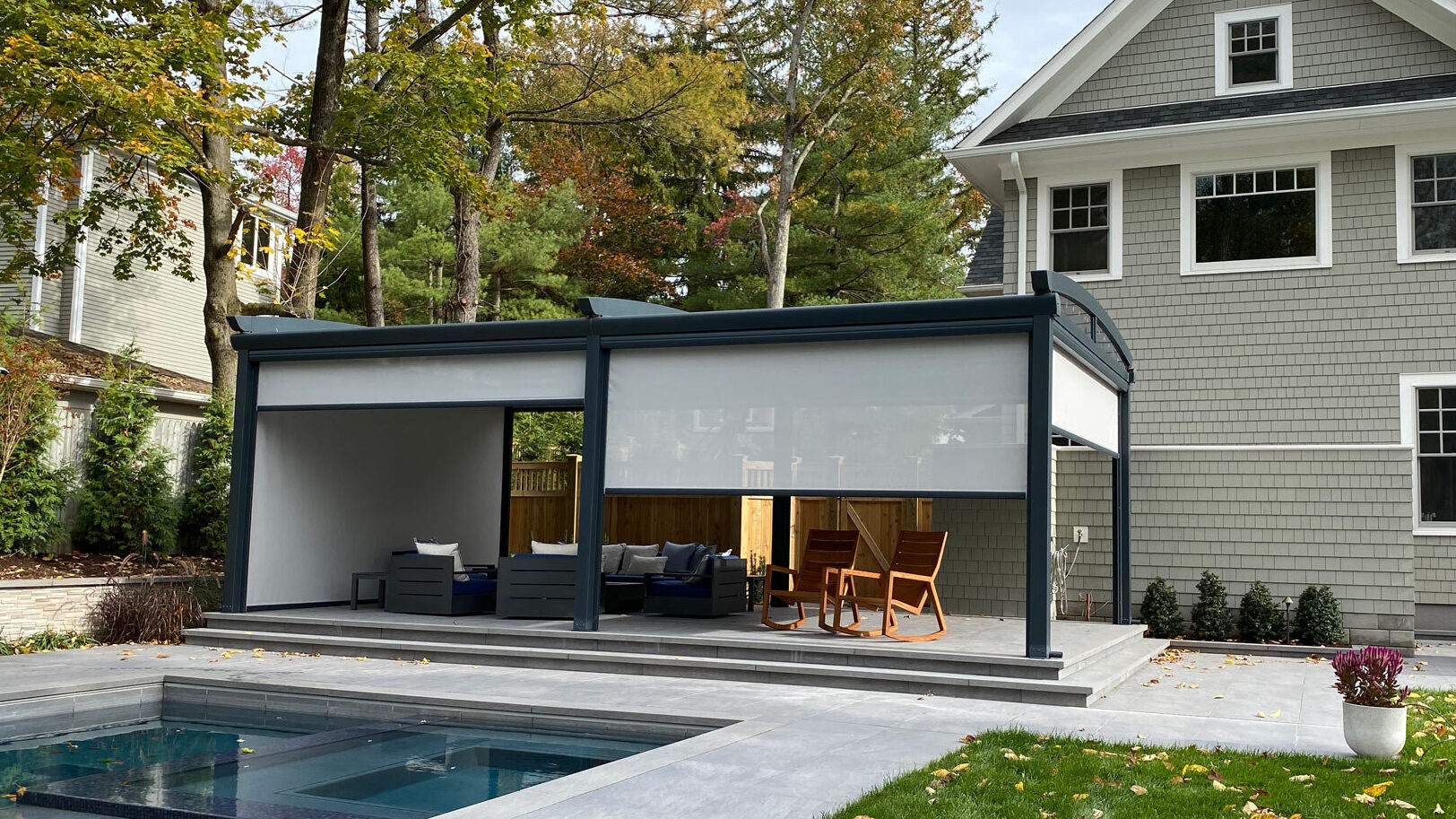🌿 Choosing a Pergola: Your Aluminum Pergola Buying Guide
💡 Why is this article important?
Choosing a pergola is a joyous moment, as it can completely transform your outdoor lifestyle—turning a bare yard into a luxurious extension of your home.
However, for a first-time pergola buyer, with so many options in materials, features, and sizes, it’s easy to make costly mistakes.
✅ Your Ultimate Checklist
This aluminum-pergola-buying-guide is designed to be your ultimate checklist before purchasing.
Drawing on 20 years of experience in manufacturing and sales,
we’ve identified nine key factors to ensure you’re choosing the perfect pergola.
📝 Nine Pre-Purchase Pergola Checklist
1️⃣ Homeowners Association (HOA) and Municipal Permits

This is the most important first step. Without HOA or municipal approval or permits,
even if you purchase a pergola and have it installed, it could be removed for violating regulations!
✅ Location: Can it only be built in the backyard, or can it be attached to the side of the house?
How far away from the neighbor’s fence does it have to be?
✅ Size: Are there any restrictions on the height of the pergola or the percentage of the yard it can cover?
✅ Material and Color: Some communities in the United States have strict regulations to maintain a uniform appearance.
Read your HOA agreement and check with your local building department first.
👉 For a deeper understanding of the permitting process, read our complete guide to
pergola installation costs, which includes a detailed section.
2
Climate Conditions (Durability Testing)

Extreme weather is an inevitable test for any outdoor structure. Choosing materials that can withstand these extremes is a responsible investment.
🌧 High humidity/rain: Wood rots, steel rusts. Aluminum is unaffected.
❄️ Snowy: High-strength aluminum is engineered to withstand heavy snow loads up to 60-80 cm.
🌊 Coastal salt spray: Salt is extremely corrosive to steel and wood. Marine-grade powder-coated aluminum is the only material that can reliably withstand salt spray.
☀️ Strong UV rays/sunlight: Wood fades and cracks, and steel suffers from coating discoloration and surface degradation. Aluminum with a high-quality UV-resistant coating, however, retains its color and integrity for decades.
✅ Action Step:
Always match your pergola material to your local climate. Aluminum with protective coatings offers the longest lifespan across all conditions.
3
The Perfect Location (Placement is Key)

Where do you plan to install the pergola? The location dictates the best type and style.
🏡 Backyard/Patio: The most common location, perfect for creating an outdoor living room or dining area.
🏊 Poolside: Requires a highly corrosion-resistant material like aluminum to withstand chlorine splash.
🏢 Rooftop or Balcony: Requires a lightweight yet strong material and professional confirmation of the building’s load-bearing capacity.
📌 Action Step:
Decide the location first—this will directly determine the right material, style, and installation method for your pergola.
4
Right-Sizing Your Pergola (Matching Your Yard)

Bigger isn’t always better. A pergola should be proportional to your space.
📏 Small Yard (<800 sq ft): Opt for a compact model (e.g., 10’x12′). An attached or wall-mounted style can save precious ground space.
📐 Medium Yard (800-1500 sq ft): A standard 12’x16′ pergola is perfect for a full dining or lounge set.
🏞️ Large Yard (>1500 sq ft): You have the freedom for a large, extended model (16’x20′ or bigger) to create a true multi-zone outdoor destination.
📌 Action Step:
Measure your yard first, then match the pergola size to ensure balance and usability without overwhelming your outdoor space.
5
Installation Method (Freestanding vs. Attached vs. Suspension)
How the pergola is anchored impacts both the look and the purchasing decision?
🏡 Freestanding: Stands on its own on four or more posts. Offers the most flexibility in placement.
🏊 Attached: Connects to the exterior wall of your house. Creates a seamless transition from indoors to outdoors.
🏢 Susprnsion: Eliminates the posts and supports the pergola with overhead tensioning, resulting in an open view and elegant appearance.
📌 Action Step:
Each method has unique pros and cons. To explore them in detail, see our Freestanding vs. Attached Pergola Guide.
6
The Opening Mechanism (Manual vs. Electric)

What do you want your roof to do?
📏 Manual Louvered Roof: Allows you to adjust the slats by hand for a balance of sun and shade. A great budget-conscious option.
📐 Electric Bioclimatic Roof: The ultimate in luxury and convenience. Control the louvers with a remote, and often includes smart features like rain sensors that automatically close the roof.
7
Smart Features & Add-ons (The Upgrades)
Consider which upgrades you want from the start, as it’s often easier and cheaper to have them integrated during manufacturing.

1, Integrated LED Lighting

2, Electric windproof roller blind

3, Frameless Glass Door

4, Wind And Rain Sensor
📌 Action Step:
Each integration offers different capabilities.
For a more detailed look, see our analysis of 11 high-tech pergola features.
8
Brand Quality and Warranty (Long-Term Value)

Buying a pergola isn’t just a one-time purchase; it’s a long-term investment.
Choosing a manufacturer with a strong reputation and a commitment to quality is crucial.
A reliable brand not only ensures stable performance over years of use but also offers a comprehensive warranty, giving you peace of mind and confidence.
So, the question is: How do you determine a brand’s reliability?
When choosing a pergola brand, beyond appearance and price, you should also consider the following aspects to determine its trustworthiness:
1. Market Reputation and Customer Reviews
Check genuine reviews on different platforms to validate trustworthiness.
- Look at official websites, third-party platforms, and social media.
- If customers consistently report fast after-sales service, smooth installation, and long-term stable use, you can feel confident.
2. Case Studies and Project Experience
Real-world cases reflect the brand’s proven performance.
- Reliable manufacturers share actual project examples with pictures and details.
- If a brand provides successful cases in local or similar environments, it’s a strong sign of credibility.
3. Product Testing and Certification
Certifications prove the product has passed rigorous testing.
- Look for international or regional standards such as CE, ISO, ASTM.
- These confirm that materials and workmanship can withstand long-term use and environmental challenges.
4. Transparency of Warranty Policy
Warranty clarity shows the brand’s confidence.
- Don’t just check the length of the warranty period.
- Pay attention to whether it covers paint discoloration, electrical failures, or just structural damage.
5. After-Sales Service and Support
Strong service reflects commitment to customers.
- A reliable brand offers comprehensive customer service and installation support.
- Evaluate their communication efficiency and problem resolution speed to measure reliability.
9
Long-Term Maintenance (The Real Cost)

The purchase price is only part of the story.
The long-term cost of ownership is a critical buying factor.
Wood Pergolas: Require annual staining and sealing ($300-$500/year) and replacement of rotten boards every few years ($800+).
Steel Pergolas: Need annual rust inspection and repainting ($200-$300/year).
Aluminum Pergolas: Require only an occasional cleaning with soap and water. The long-term maintenance cost is virtually zero, making it the most cost-effective solution over the life of the product.
📌 Action Step:
Before enjoying your pergola, think ahead about long-term care. Our pergola maintenance guide shows you how to keep it looking and performing like new.
Your Purchase is a Plan, Not Just a Product
By walking through this 9-point checklist, you’ve moved from being a shopper to a planner.
You now have the knowledge to select a pergola that not only looks beautiful on day one but also
serves your lifestyle and lasts for decades to come.
See how these factors come together in our Ultimate 2025 Pergola Cost Guide.


